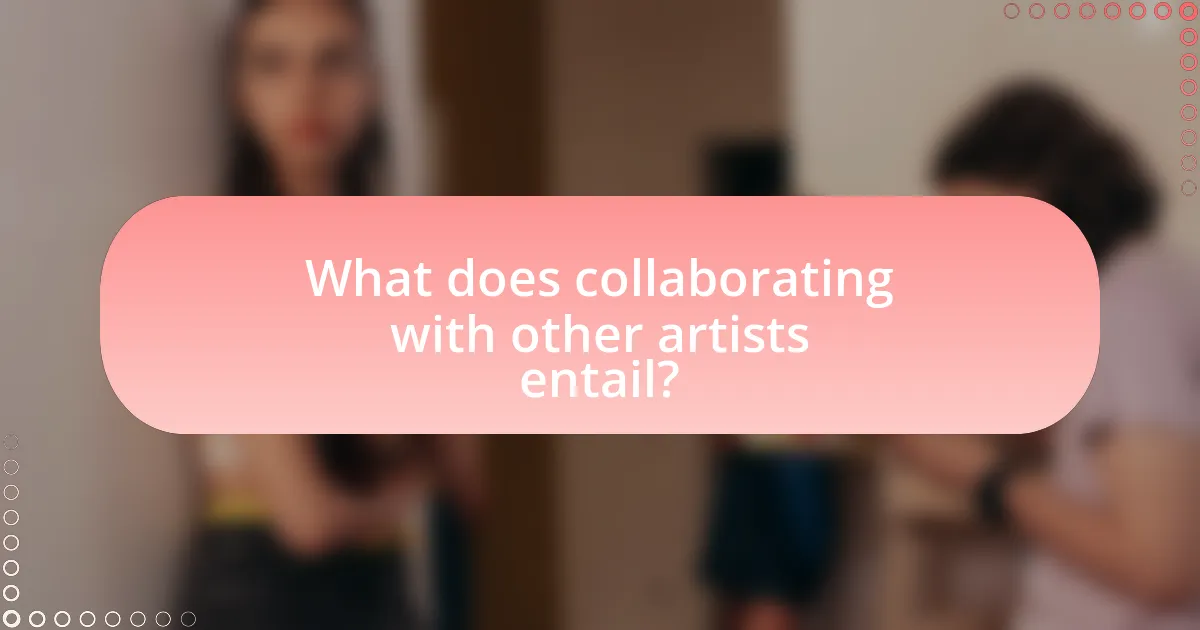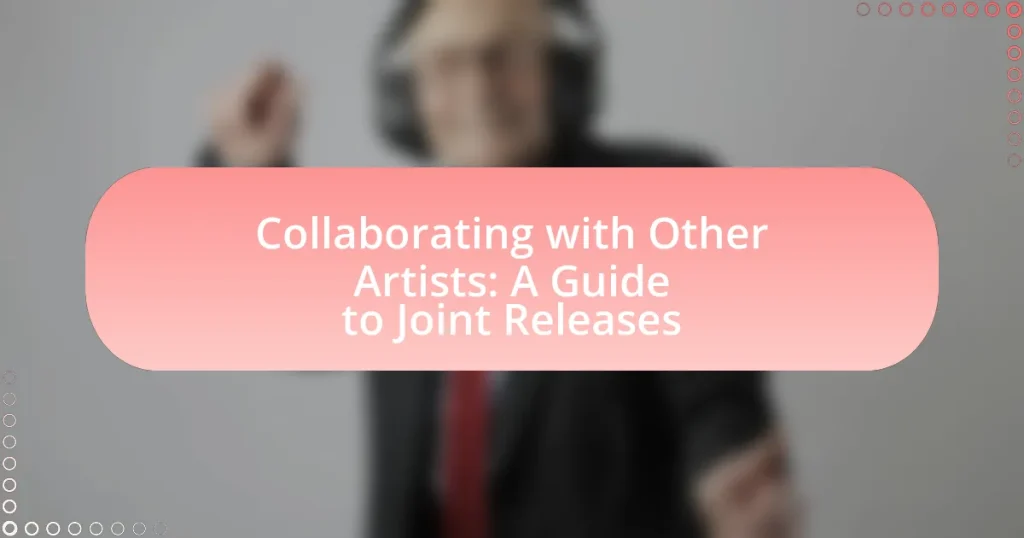Collaborating with other artists involves working together on shared artistic projects, such as music, visual art, or performance, to combine individual skills and ideas. This article outlines the process of identifying potential collaborators, the qualities to seek in a partner, and effective approaches for initiating collaboration. It also explores various types of collaborations, including joint releases and interdisciplinary projects, while highlighting the benefits of collaboration, such as enhanced creativity and increased audience reach. Additionally, the article addresses logistical considerations, marketing strategies, and best practices for successful collaborations, including conflict resolution and maintaining positive working relationships.

What does collaborating with other artists entail?
Collaborating with other artists entails the process of working together to create shared artistic projects, which can include music, visual art, or performance. This collaboration typically involves combining individual skills, ideas, and resources to produce a final work that reflects the contributions of all involved artists. For instance, in the music industry, artists may co-write songs, share production duties, or perform together, leading to unique soundscapes that neither could achieve alone. Collaborative projects often result in increased exposure and access to each artist’s audience, enhancing their reach and impact in the art community.
How can artists identify potential collaborators?
Artists can identify potential collaborators by actively engaging in their artistic communities and utilizing social media platforms. By attending local art events, workshops, and exhibitions, artists can meet like-minded individuals and gauge their compatibility for collaboration. Additionally, platforms like Instagram and Behance allow artists to showcase their work and connect with others in their field, facilitating the discovery of potential partners. Research indicates that networking within creative circles significantly increases collaboration opportunities, as artists who participate in community events are more likely to find collaborators who share similar artistic visions and goals.
What qualities should artists look for in a collaborator?
Artists should look for complementary skills, effective communication, and shared vision in a collaborator. Complementary skills ensure that each artist brings unique strengths to the project, enhancing creativity and productivity. Effective communication fosters a collaborative environment where ideas can be freely exchanged, leading to better outcomes. A shared vision aligns both artists’ goals and artistic direction, which is crucial for a cohesive final product. Research indicates that successful collaborations often stem from these qualities, as they facilitate synergy and mutual understanding, ultimately resulting in more impactful artistic work.
How can artists approach potential collaborators effectively?
Artists can approach potential collaborators effectively by conducting thorough research on their work and establishing a clear, personalized communication strategy. By understanding the collaborator’s style, audience, and previous projects, artists can tailor their outreach to highlight mutual benefits and shared goals. For instance, a study by the National Endowment for the Arts indicates that successful collaborations often stem from a foundation of shared artistic vision and complementary skills, which can be emphasized in initial communications. Additionally, artists should present a well-defined project idea that outlines how the collaboration will enhance both parties’ artistic expressions, thereby increasing the likelihood of a positive response.
What are the different types of collaborations in the art world?
Different types of collaborations in the art world include artist collaborations, interdisciplinary collaborations, community-based collaborations, and commercial collaborations. Artist collaborations involve two or more artists working together on a single piece or project, often blending their unique styles and techniques. Interdisciplinary collaborations occur when artists partner with professionals from other fields, such as science or technology, to create innovative works that merge different disciplines. Community-based collaborations engage local communities in the artistic process, often resulting in public art projects that reflect the community’s identity. Commercial collaborations involve artists partnering with brands or businesses to create art for marketing or product design, which can enhance visibility and reach for both parties. These collaboration types are essential for fostering creativity and expanding the impact of art in various contexts.
What are joint releases, and how do they differ from other collaborations?
Joint releases are collaborative projects where two or more artists produce and distribute a single work, such as an album or a song, under a unified title and branding. Unlike other collaborations, which may involve artists contributing separately to a project or featuring on each other’s tracks without a cohesive release, joint releases emphasize a shared vision and equal partnership in the creative process. This distinction is evident in the way joint releases are marketed and credited, often highlighting the collaborative nature as a singular entity, whereas other collaborations may not have the same level of integration or joint ownership.
How can artists collaborate across different mediums?
Artists can collaborate across different mediums by integrating their unique skills and perspectives to create multidisciplinary works. For instance, a visual artist can partner with a musician to produce an immersive experience that combines visual art with sound, enhancing the emotional impact of both forms. This approach has been exemplified in projects like the “Light and Sound” installations, where artists from various disciplines come together to create cohesive experiences that engage audiences on multiple sensory levels. Such collaborations often lead to innovative outcomes that push the boundaries of traditional art forms, as seen in the works of artists like Olafur Eliasson and Brian Eno, who have successfully merged visual and auditory elements in their projects.
What are the benefits of collaborating with other artists?
Collaborating with other artists enhances creativity and expands audience reach. When artists work together, they combine diverse skills and perspectives, leading to innovative ideas and unique artistic expressions. For instance, a study by the National Endowment for the Arts found that collaborative projects often result in higher-quality work due to the pooling of resources and talents. Additionally, partnerships can introduce artists to each other’s fan bases, significantly increasing visibility and potential sales. This synergy not only fosters personal growth but also strengthens the artistic community as a whole.
How does collaboration enhance creativity and innovation?
Collaboration enhances creativity and innovation by combining diverse perspectives and skills, leading to unique ideas and solutions. When individuals from different backgrounds work together, they share knowledge and experiences that can spark new concepts. Research by the Harvard Business Review indicates that teams with varied expertise generate more innovative outcomes compared to homogenous groups. This diversity fosters an environment where unconventional ideas can emerge, ultimately driving creative processes and innovative results.
What impact does collaboration have on audience reach and engagement?
Collaboration significantly enhances audience reach and engagement by combining the fan bases of the involved artists. When two or more artists collaborate, they expose each other to their respective audiences, leading to increased visibility and potential new followers. For instance, a study by Nielsen Music found that collaborative tracks often achieve higher streaming numbers, as they attract listeners from both artists’ fan bases, resulting in a broader audience engagement. This cross-pollination effect not only boosts the reach but also fosters deeper engagement, as fans are more likely to interact with content that features their favorite artists together.

What are the key steps in planning a joint release?
The key steps in planning a joint release include establishing clear communication, defining roles and responsibilities, creating a timeline, coordinating marketing efforts, and finalizing distribution channels. Clear communication ensures all parties are aligned on goals and expectations, while defining roles clarifies who is responsible for each aspect of the project. A well-structured timeline helps manage deadlines and milestones, and coordinated marketing efforts maximize reach and impact. Finally, finalizing distribution channels ensures that the release is accessible to the target audience. These steps are essential for a successful collaboration, as they foster organization and synergy among the artists involved.
How should artists define their goals for the collaboration?
Artists should define their goals for collaboration by clearly identifying their desired outcomes and the specific contributions they aim to make. This involves setting measurable objectives, such as increasing audience reach, enhancing creative skills, or producing a specific type of work. For instance, a study by the National Endowment for the Arts highlights that collaborations can lead to innovative artistic expressions and broaden market opportunities, emphasizing the importance of goal alignment among collaborators. By establishing these goals upfront, artists can ensure that their collaborative efforts are focused, productive, and mutually beneficial.
What factors should be considered when setting collaborative objectives?
When setting collaborative objectives, it is essential to consider the alignment of goals among all participants. This alignment ensures that each artist’s vision and expectations are compatible, fostering a cohesive creative process. Additionally, the distribution of roles and responsibilities must be clearly defined to avoid confusion and ensure accountability. Effective communication strategies should also be established to facilitate ongoing dialogue and feedback throughout the collaboration. Furthermore, timelines and deadlines are critical to maintain momentum and ensure that the project progresses as planned. Lastly, evaluating the potential audience and market for the collaborative work can guide the objectives to ensure they resonate with the intended demographic.
How can artists align their visions for a successful joint release?
Artists can align their visions for a successful joint release by establishing clear communication and shared goals from the outset. This involves discussing each artist’s creative direction, target audience, and desired outcomes to ensure that all parties are on the same page. Research indicates that successful collaborations often stem from mutual respect and understanding of each artist’s strengths and weaknesses, which can enhance the overall quality of the project. By setting specific milestones and regularly checking in on progress, artists can maintain alignment throughout the creative process, ultimately leading to a cohesive and impactful joint release.
What logistical considerations are involved in a joint release?
Logistical considerations in a joint release include coordination of schedules, distribution agreements, and marketing strategies. Effective collaboration requires aligning timelines for recording, mixing, and mastering to ensure all parties are available and on the same page. Distribution agreements must be established to determine how revenue will be shared and which platforms will be used for release. Additionally, a cohesive marketing strategy is essential to promote the joint project effectively, which may involve joint promotional events, social media campaigns, and coordinated press releases. These elements are critical to ensure a successful joint release that maximizes reach and impact.
How can artists manage timelines and deadlines effectively?
Artists can manage timelines and deadlines effectively by utilizing project management tools and setting clear milestones. These tools, such as Trello or Asana, allow artists to break down projects into manageable tasks, assign deadlines, and track progress. Research indicates that 71% of creative professionals find project management software enhances their productivity, enabling them to meet deadlines consistently. Additionally, establishing regular check-ins with collaborators fosters accountability and ensures that everyone is aligned on progress and expectations. By implementing these strategies, artists can streamline their workflow and enhance their ability to meet deadlines in collaborative projects.
What are the best practices for sharing resources and responsibilities?
The best practices for sharing resources and responsibilities in collaborative artistic projects include establishing clear communication, defining roles and expectations, and creating a shared resource management plan. Clear communication ensures that all parties are aligned on goals and progress, which is essential for successful collaboration. Defining roles and expectations helps prevent misunderstandings and ensures that each artist knows their responsibilities, thereby enhancing accountability. A shared resource management plan outlines how resources such as time, finances, and materials will be allocated and utilized, which is crucial for maintaining efficiency and transparency throughout the project. These practices are supported by research indicating that effective collaboration leads to higher quality outcomes and increased satisfaction among participants.

How can artists promote their joint releases effectively?
Artists can promote their joint releases effectively by leveraging social media platforms, engaging in cross-promotion, and utilizing targeted marketing strategies. Social media allows artists to reach a wider audience by sharing content related to their collaboration, such as behind-the-scenes footage, teasers, and promotional graphics. Cross-promotion involves each artist sharing the release on their individual channels, thereby tapping into each other’s fan bases. Additionally, targeted marketing strategies, such as email newsletters and paid advertisements, can help reach specific demographics interested in the genre or style of the collaboration. According to a study by the International Journal of Arts Management, collaborations can increase visibility and engagement by up to 50% when both artists actively promote the release.
What marketing strategies work best for joint releases?
Collaborative marketing strategies that work best for joint releases include cross-promotion, leveraging social media platforms, and utilizing email marketing campaigns. Cross-promotion allows each artist to tap into the other’s fan base, significantly increasing reach and engagement. For instance, when two artists announce a joint release, they can share content on their respective social media channels, leading to a combined audience exposure that can double or triple the potential listener base.
Additionally, social media platforms like Instagram and TikTok are effective for creating buzz through teaser content, behind-the-scenes footage, and interactive posts that encourage fan participation. A study by Nielsen Music found that social media engagement can lead to a 30% increase in streaming numbers for collaborative projects.
Email marketing campaigns can also be tailored to announce the joint release, offering exclusive content or pre-save links to both artists’ mailing lists, which can enhance anticipation and drive initial sales. According to a report by HubSpot, personalized email campaigns can yield a 29% higher open rate, making them a powerful tool for joint releases.
How can social media be leveraged to promote collaborations?
Social media can be leveraged to promote collaborations by facilitating direct communication and engagement between artists and their audiences. Platforms like Instagram, Twitter, and Facebook allow artists to share their collaborative projects, tag each other, and reach a wider audience through shared posts and stories. For instance, a study by the Pew Research Center indicates that 72% of adults use social media, providing a vast network for artists to connect and promote joint releases effectively. Additionally, using targeted hashtags and participating in relevant online communities can enhance visibility and attract potential collaborators, thereby fostering a collaborative environment.
What role do press releases and media outreach play in promotion?
Press releases and media outreach are essential tools in promotion as they facilitate the dissemination of information about new releases, events, or collaborations to a wider audience. By crafting a well-structured press release, artists can effectively communicate key details and generate interest among journalists, bloggers, and influencers, which can lead to increased visibility and coverage in various media outlets. For instance, a study by the Public Relations Society of America indicates that 70% of journalists prefer receiving information through press releases, highlighting their importance in media communication. This outreach not only enhances an artist’s credibility but also amplifies their reach, making it a critical component of successful promotional strategies in the music industry.
What are common challenges faced during collaborations?
Common challenges faced during collaborations include communication issues, differing artistic visions, and logistical complications. Communication problems often arise from unclear expectations or lack of regular updates, leading to misunderstandings. Differing artistic visions can create conflict when collaborators have contrasting ideas about the project’s direction, which can hinder progress. Logistical complications, such as scheduling conflicts and resource allocation, can also impede collaboration efforts. According to a study published in the Journal of Creative Behavior, 70% of collaborative projects experience significant delays due to these challenges, highlighting the importance of addressing them proactively.
How can artists navigate creative differences?
Artists can navigate creative differences by establishing open communication and setting clear expectations from the outset. This approach fosters an environment where each artist feels valued and understood, allowing for constructive discussions about differing visions. Research indicates that successful collaborations often hinge on the ability to compromise and find common ground, which can lead to innovative outcomes that blend diverse perspectives. For instance, a study published in the Journal of Creative Behavior highlights that teams with effective communication strategies are more likely to produce high-quality collaborative work.
What strategies can help resolve conflicts in a collaborative setting?
Effective strategies to resolve conflicts in a collaborative setting include open communication, active listening, and establishing clear roles and responsibilities. Open communication allows all parties to express their concerns and perspectives, fostering an environment of trust. Active listening ensures that each participant feels heard and valued, which can de-escalate tensions. Establishing clear roles and responsibilities helps prevent misunderstandings and overlaps in duties, reducing the likelihood of conflict. Research indicates that teams with defined roles experience 25% fewer conflicts, highlighting the importance of clarity in collaborative efforts.
What are some best practices for successful collaborations?
Successful collaborations require clear communication, defined roles, and mutual respect among all parties involved. Establishing open lines of communication ensures that all collaborators can express their ideas and concerns, which fosters a productive environment. Clearly defining roles helps to avoid confusion and overlap in responsibilities, allowing each artist to contribute their strengths effectively. Additionally, mutual respect for each other’s artistic vision and contributions is crucial, as it builds trust and encourages creativity. Research indicates that teams with high levels of trust and respect are more likely to achieve successful outcomes, as highlighted in studies on collaborative creativity in the arts.
How can clear communication enhance collaboration outcomes?
Clear communication enhances collaboration outcomes by ensuring that all participants have a shared understanding of goals, roles, and expectations. When artists communicate clearly, they reduce the likelihood of misunderstandings, which can lead to conflicts or delays in the collaborative process. Research indicates that effective communication can improve team performance by up to 25%, as it fosters trust and encourages open dialogue, allowing for more innovative ideas and solutions to emerge. This is particularly crucial in artistic collaborations, where diverse perspectives must be harmonized to create a cohesive final product.
What tips can help maintain a positive working relationship between artists?
To maintain a positive working relationship between artists, clear communication is essential. Artists should establish open lines of dialogue to discuss expectations, creative visions, and feedback throughout the collaboration process. This approach fosters mutual understanding and minimizes misunderstandings. Additionally, setting defined roles and responsibilities helps each artist know their contributions, which can enhance accountability and respect. Regular check-ins can also facilitate ongoing collaboration and address any issues promptly. Research indicates that effective communication and role clarity significantly improve team dynamics and project outcomes in creative collaborations.


